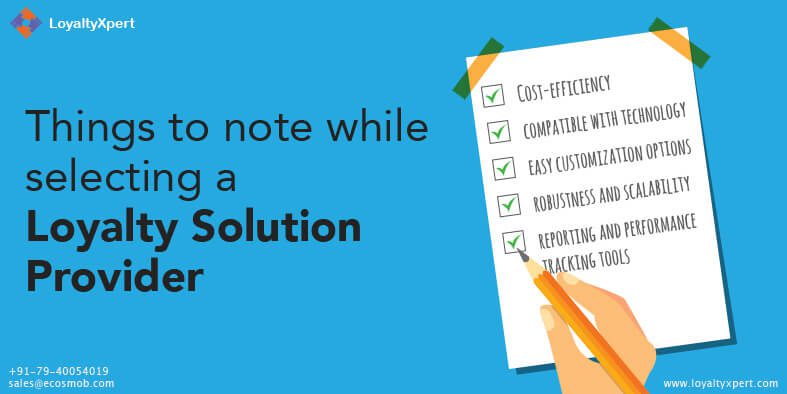
Things to Note While Selecting A Loyalty Solution Provider
Author
Khushal Fadiya
Published on:
Sep 7, 2018
Table of Content
See How Our Loyalty Program Can Help You.
Let us guide you through our product features with Loyalty Experts
Startups and large businesses face one of these two ordeals—high customer acquisition cost or losing existing customers to their rival brands.
With many factors dictating the financial aspects of marketing and lead generation, customer acquisition under a limited budget would be little too far-fetched for businesses to achieve in a short span. This leaves them with the only option– building attractive loyalty programs to lure their current customers to engage with them for a longer duration.
But the pressure to compete with rival brands, changing trends and increasing customer expectations have made it quite tough to keep the customers pinned to the brands. A survey by the IRI Consumer Connect found that nearly 74 percent of customers select a store because of the loyalty points or discount programs that the brand is offering. Incidentally, another study found that 79% of customers look for deals and loyalty points before engaging in buying activities. This study also confirmed that customers keep a tab on discounts and loyalty points irrespective of the prevailing economic conditions to save money.
Having an eye on the best deals, discounts and attractive loyalty rewards has become the habit of modern buyers!
To cope with the changing expectations of customers, businesses devise loyalty programs that not only solve the problem of rapid customer attrition but also help them win customers’ trust.
Customer loyalty has a direct effect on profit generation because loyal customers tend to spend more than others (study confirms). Besides, loyal customers serve as good ambassadors for the brand by sharing their positive feedback and experiences with their peers, inviting more individuals to engage with the brand. After all, great word-of-mouth is the most effective way to introduce a brand to new customers.
Besides profits, great ratings and reviews from customers on social media are important for both new and old customers to be associated with a brand. Loyalty expert solution providers and marketers need to know when to look beyond and over profits and customer retention and make customer satisfaction the core criteria while building enchanting loyalty programs.
That’s because sometimes businesses may go overboard in pleasing customers. The 2017 Loyalty Report revealed that on average a customer is involved with at least 14 loyalty programs. Unfortunately, they can engage in only seven loyalty programs, preventing businesses from deriving value out of their loyalty programs.
To avoid costly risks and efforts to futile in influencing customers to remain loyal to the brands, compiled below are some of the important considerations to make while selecting a loyalty solution provider for a business:
1. Cost-efficiency
New businesses and growing brands often tend to make poor calling by signing up with an expensive loyalty solution provider with plans that are irrelevant to their brands. In a few cases, the loyalty programs do not resonate with the product or brand philosophy and customer demographics, leading to wastage of efforts and financial resources.
Marketers need to consider the economics behind the implementation and practice of offering loyalty plans and reward points for customers to ensure they do not overspend and lose out on profit margins. From customers’ standpoint businesses need to assess whether the membership cost and other miscellaneous fees attract or repel customers to engage with the brand.
2. Easy to Test and Compatible with Existing Technological Infrastructure
Whether it is integrating with POS, CRM platforms or other mobile-first platforms and tools that businesses use to engage with customers, the loyalty program solution must provide users to ability measure, track and analyse the effects it has on customer behaviours. The solution must have easy to implement and use daily without much technical difficulties and need for training.
3. Easy Customization Options
The adage-one size fits all does not apply in customer loyalty. Businesses need to look for solutions offered by loyalty program platform providers that have customization capabilities to design reward, discount and loyalty plans according to different customers profiles. Some customers prefer redeeming their points with cash back programs, while other expect brands to reward them in kinds like issuing gift cards and coupons, etc. A smart loyalty program software is the one that adapts to businesses’ need and marketing goals.
4. Robustness and Scalability
Brands that do offline businesses as well as e-commerce firms which are looking to expand their offline reach by launching physical stores in multiple locations, the loyalty solution platform should seamlessly fit to support growth. Besides the robustness and scalability factors is needed to support long-term objectives of the business and ability to manage a large number of diverse clientele.
5. Reporting and Performance Tracking Tools
Businesses can avoid going to marketing agencies using loyalty and reward program solutions that are built with superior analytics and reporting tools to churn data for best insights and measure the performance of loyalty programs. This makes businesses self-sufficient in terms of understanding their customers, identifying loyal customers and rewarding them appropriately. These kind of loyalty programs are also useful in planning new strategies for brand and customer loyalty, discover new opportunities for sales and influence existing customers to engage in repurchase activities.
Consult our loyalty program experts to solve your queries on customer retention and strategies for better customer loyalty.
FAQs
Khushal Fadiya
The driving force behind LoyaltyXpert, has poured his heart and soul into nurturing and growing the company, which he proudly considers his "baby." With an unwavering passion for technology, Khushal has seamlessly integrated his love for tech into his role as Associate Director, where he continues to play a pivotal role in the company’s ongoing success and innovation.



